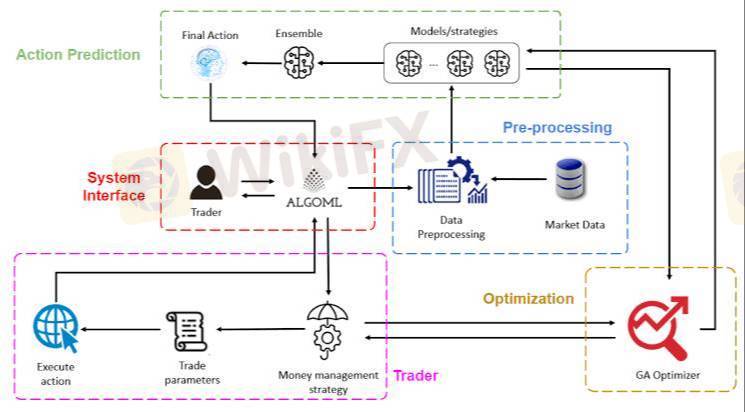
2025-02-27 04:25
IndustryAI-powered forex trading model improvements using.
#AITradingAffectsForex
The application of reinforcement learning (RL) to improve AI-powered forex trading models is a very active area of research and development. Here's a breakdown of key concepts and how RL contributes:
Understanding Reinforcement Learning in Forex Trading:
* Core Idea:
* RL involves an "agent" (the trading model) that learns to make decisions by interacting with an "environment" (the forex market).
* The agent receives "rewards" for profitable trades and "penalties" for losses.
* Through repeated interactions, the agent optimizes its trading strategy to maximize rewards.
* How it Works:
* State: The agent observes the current state of the market (e.g., price trends, indicators).
* Action: Based on the state, the agent takes an action (e.g., buy, sell, hold).
* Reward: The agent receives feedback in the form of a reward or penalty based on the outcome of the trade.
* Learning: The agent updates its strategy based on the feedback, aiming to improve future decisions.
Key Improvements and Advantages:
* Adaptability:
* Forex markets are highly dynamic and unpredictable. RL models can adapt to changing market conditions in real-time.
* They can learn to identify and exploit new patterns and trends.
* Optimization of Trading Strategies:
* RL can optimize complex trading strategies that involve multiple factors, such as entry and exit points, risk management, and position sizing.
* It can learn to balance risk and reward effectively.
* Automation:
* RL enables the development of fully automated trading systems that can execute trades without human intervention.
* This can reduce emotional bias and improve trading efficiency.
* Handling Complexity:
* Forex data is very complex. RL algorithms are very good at handling very complex data sets, and finding non-linear relationships within that data.
Challenges:
* Data Requirements: RL models require large amounts of high-quality historical data for training.
* Overfitting: There is a risk of overfitting the model to historical data, which can lead to poor performance in live trading.
* Market Noise: Forex markets are subject to significant noise, which can make it difficult for RL models to identify meaningful patterns.
* Computational Cost: Training RL models can be computationally intensive.
In summary:
Reinforcement learning offers a powerful approach to improving AI-powered forex trading models. By learning from experience and adapting to changing market conditions, RL can help to develop more robust and profitable trading strategies.
Like 0
Baara
Trader
Hot content
Industry
Event-A comment a day,Keep rewards worthy up to$27
Industry
Nigeria Event Giveaway-Win₦5000 Mobilephone Credit
Industry
Nigeria Event Giveaway-Win ₦2500 MobilePhoneCredit
Industry
South Africa Event-Come&Win 240ZAR Phone Credit
Industry
Nigeria Event-Discuss Forex&Win2500NGN PhoneCredit
Industry
[Nigeria Event]Discuss&win 2500 Naira Phone Credit
Forum category

Platform

Exhibition

Agent

Recruitment

EA

Industry

Market

Index
AI-powered forex trading model improvements using.
 India | 2025-02-27 04:25
India | 2025-02-27 04:25#AITradingAffectsForex
The application of reinforcement learning (RL) to improve AI-powered forex trading models is a very active area of research and development. Here's a breakdown of key concepts and how RL contributes:
Understanding Reinforcement Learning in Forex Trading:
* Core Idea:
* RL involves an "agent" (the trading model) that learns to make decisions by interacting with an "environment" (the forex market).
* The agent receives "rewards" for profitable trades and "penalties" for losses.
* Through repeated interactions, the agent optimizes its trading strategy to maximize rewards.
* How it Works:
* State: The agent observes the current state of the market (e.g., price trends, indicators).
* Action: Based on the state, the agent takes an action (e.g., buy, sell, hold).
* Reward: The agent receives feedback in the form of a reward or penalty based on the outcome of the trade.
* Learning: The agent updates its strategy based on the feedback, aiming to improve future decisions.
Key Improvements and Advantages:
* Adaptability:
* Forex markets are highly dynamic and unpredictable. RL models can adapt to changing market conditions in real-time.
* They can learn to identify and exploit new patterns and trends.
* Optimization of Trading Strategies:
* RL can optimize complex trading strategies that involve multiple factors, such as entry and exit points, risk management, and position sizing.
* It can learn to balance risk and reward effectively.
* Automation:
* RL enables the development of fully automated trading systems that can execute trades without human intervention.
* This can reduce emotional bias and improve trading efficiency.
* Handling Complexity:
* Forex data is very complex. RL algorithms are very good at handling very complex data sets, and finding non-linear relationships within that data.
Challenges:
* Data Requirements: RL models require large amounts of high-quality historical data for training.
* Overfitting: There is a risk of overfitting the model to historical data, which can lead to poor performance in live trading.
* Market Noise: Forex markets are subject to significant noise, which can make it difficult for RL models to identify meaningful patterns.
* Computational Cost: Training RL models can be computationally intensive.
In summary:
Reinforcement learning offers a powerful approach to improving AI-powered forex trading models. By learning from experience and adapting to changing market conditions, RL can help to develop more robust and profitable trading strategies.
Like 0
I want to comment, too
Submit
0Comments

There is no comment yet. Make the first one.

Submit
There is no comment yet. Make the first one.